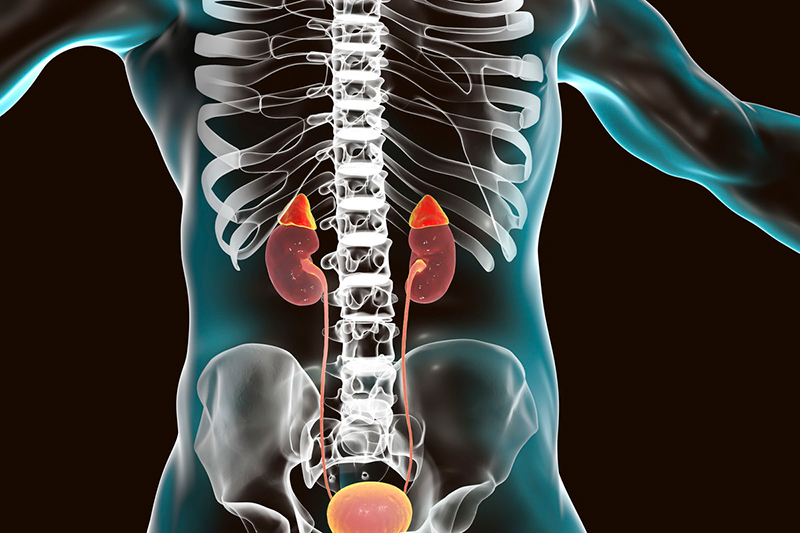NIH researchers among panelists evaluating options for pheochromocytoma and paraganglioma

Researchers at the National Institutes of Health led an international team to develop consensus guidelines on the appropriate use of a specialized form of radiation therapy for patients with pheochromocytoma and paraganglioma—rare cancers— that have spread. These therapies are typically provided with drugs known as radionuclides, which consist of a central molecule bound to a radioactive element. The radioactive molecules can be tracked by imaging methods to provide detailed images of the tumors and their location in the body. Because these drugs are taken into the tumor cells, they can also be used to treat the tumor. This consensus is based on the panel’s review of treatment studies, and consideration of the circumstances under which their use is warranted, based on patients’ ability to tolerate them, their side effects, previous treatments, and other considerations.
The team was co-led by Abhishek Jha, M.B.B.S., a research fellow, and Karel Pacak, M.D., D.Sc., Ph.D., a senior investigator in the Section on Medical Neuroendocrinology at NIH’s Eunice Kennedy Shriver National Institute of Child Health and Human Development (NICHD). The review appears in Clinical Cancer Research.
Background
Chromaffin cells release hormones that respond to stress, monitor carbon dioxide and oxygen in the body, and regulate heart rate and blood pressure. Tumors arising from chromaffin cells in the adrenal glands are called pheochromocytomas, and tumors resulting from chromaffin cells in other parts of the body are called paragangliomas. These tumors may produce catecholamines, hormones that can increase blood pressure, affect heart rate and rhythm, and may cause psychiatric symptoms.
Numerous drugs bind to special sites or, receptors, that appear on the surface of pheochromocytomas and paragangliomas. The drugs can be combined with a radioactive molecule. Because the tumor cells have higher numbers of these receptors than other cells, the radioactively labeled drugs will selectively bind to the tumor cells, allowing the tumors to be tracked with imaging technology. The radiolabeled drugs can also be used for treatment. After binding to the tumor cell receptors, they are taken inside the tumor cell, with the radioactivity soon resulting in the cancer cell’s death. Several types of radiolabeled drugs will bind to pheochromocytoma and paraganglioma, leaving physicians to decide which would be most appropriate for their patients.
To provide physicians with guidelines on their use, the consensus panel members reviewed previous studies of these drugs, their side effects, and considered the circumstances under which they are most effective.
Results
According to the panelists, the first step in evaluating a patient with an inoperable tumor or a tumor that has spread is to determine whether radionuclide therapy is appropriate for them. If the tumors are producing large amounts of catecholamines, patients may be experiencing symptoms that the drugs could worsen, such as high blood pressure, irregular heartbeat, and psychiatric symptoms. Location of the tumor is also a factor. Similarly, if the tumor is located in the vertebrae, treatment could result in damage to the spinal cord. In such cases—particularly if the tumor is not progressing—physicians may opt to treat the symptoms of excess catecholamine production.
Scans based on radionuclide drugs can determine the type of receptors the tumors are expressing and offer insight into the drugs which might be effective. Different drugs bind to different kinds of receptors. For cases in which tumors have receptors for two drugs, clinicians should consider a patient’s overall health and the drugs’ potential side effects. For example, 131I-metaiodobenzylguanidine (131I-MIBG) can lower the number of bone marrow cells and so should be reserved for patients with a high reservoir of marrow cells. In contrast, 131I-MIBG is less likely to increase catecholamine levels and is better suited to patients who have high catecholamine levels. Patients with larger tumors may be candidates for drugs that emit more energy, such as those bound with Yttrium-90.
Significance
The authors concluded that selection of patients for targeted radionuclide therapy should be personalized, based on results of imaging scans, risk factors, tumor size and location, rate of tumor progression and previous therapy.
Reference
Jha A et al. High-specific-activity 131I-MIBG vs 177Lu-DOTATATE targeted radionuclide therapy for metastatic pheochromocytoma and paraganglioma. Clinical Cancer Research. 2021. DOI: 10.1158/1078-0432.CCR-20-3703

 BACK TO TOP
BACK TO TOP